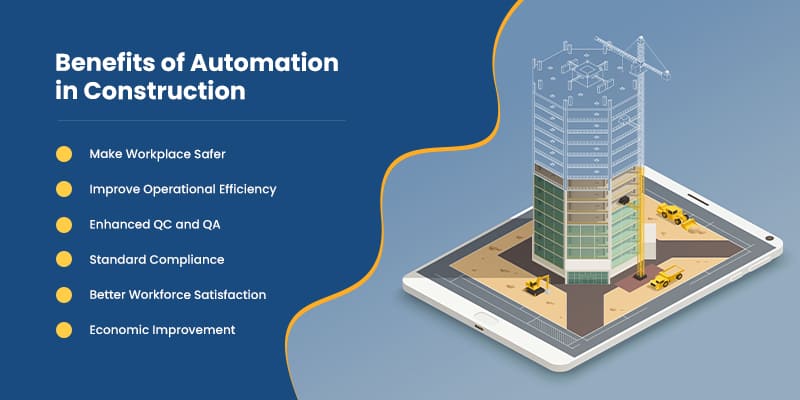
The construction industry is among the most laborious ones, meaning automation in construction would have the most use cases, opportunities, and benefits for investors.
As per research, the global building automation system market is expected to garner USD 207.5 billion by 2030. A similar study on construction robotics states that its market size will become worth USD 164 million by 2030.
Indeed, the market shows quite lucrative growth patterns. Moreover, it is quite probable that the problems associated with the construction industry, such as a decline in the quality of work, labor shortage, and unsafe working conditions, can be completely eradicated through automation.
What Is Automation in Construction?
Automation in construction, put simply, is the combination of processes, tools, and supporting systems that facilitate autonomy for daily tasks. In the construction industry, automation has the capability to improve the turnaround time for building construction, minimize depreciation rates for construction equipment, and improve quality control processes.
The process involves deploying hardware machinery, like mobile robots and edge devices, on construction sites. These machineries would be handled both manually and through artificial intelligence to achieve the perfect blend of accuracy and flexibility.
Other than improving productivity both in terms of quality and quantity, automation in construction also helps in reducing the instances of workplace accidents. Potentially hazardous tasks can easily be taken over by autonomous robots, helping achieve better accuracy in the given processes to minimize the risks and, at the same time, decreasing the potential harm to the human workforce.
Benefits of Automation in Construction

The increasing scarcity of labor skills, workplace safety requirements, high-quality standards, and regulatory compliances have long remained unavoidable challenges for the construction industry. Automation in construction has various use cases to not only deal with these challenges but open up new opportunities for scalability, improved operational efficiency, and enhanced employee retention.
Make Workplace Safer
The safety protocols and regulations are never sufficient when it comes to workplace safety in the construction industry. There always remain a number of tasks in a construction business that remain inevitably hazardous. Workers laying roofing, brick-laying at heights, working with heavy machinery, placement of heavy metal construction tools, demolition jobs, etc., all imply fatal risks. As such, automation in building construction can lead to a dramatic improvement in workplace safety.
Similarly, replacing autonomous robots and drones with cameras in potentially dangerous spaces like sewer lines, duct systems, and other cramped spaces with low-oxygen availability can improve workforce safety without affecting the quality of work.
Improve Operational Efficiency
Automation has long been known for improving operational efficiency for various organizations across sectors, and the construction industry is not an exception. For example, 3D printers and 3D-printing mixtures can be used to construct walls more efficiently, all the while meeting the standards of CMU building codes. They surpass the productivity of traditional masonry construction by far while also achieving more accurate results.
Similarly, automating the production of complex roll-form parts out of a coil of steel too has been proven to increase the output rates by eight times. The system can also be used to automate the assembling of parts to improve the construction speed in places where there is a serious lack of labor. However, the most effective placement of the given use case is in places where a huge number of constructions are required to optimize the ROI of the projects.
Enhanced QC and QA
Quality assessment and control are integral parts of an ambitious construction project. That being said, both tasks are quite laborious by nature. When the job is done manually, its tedium and intensity often result in audit lapses. In contrast, robotic technologies, cameras with edge devices, and smart sensors can bring huge autonomous benefits to assessment techniques.
For example, through thermal imaging analysis, 3D laser scans, and mobile robots’ tangible analysis, AI software can generate infrared thermography (IRT) of construction sites. This will help in the construction and quality assurance of special-requirement spaces. Similarly, a 3D laser scanner can also automate quality assessment in building construction with greater accuracy in standard compliance.
Standard Compliance
The construction industry has a complex structure of market regulations, including both statutory requirements and performance-based regulations. The growing awareness of the construction industry’s impact on the environment and the increasing drive towards sustainability further complicate the matter for construction. Businesses that are already struggling to stay aloft in the competitive market. As such, automatic compliance checking can help them a ton.
To automate the compliance process, it is important to have a complete framework in place. An integrated system will bring seamlessness to the compliance process, enabling domain experts to maintain major market regulations.
Better Workforce Satisfaction
By deploying autonomous robots and implementing RPAs for tedious and recurrent tasks, companies can ensure improved accuracy in the process and enhanced productivity. And while this use case has generally raised concerns among construction labor unions, the literal outcomes are quite different. Often employees are happy to be done with such monotonous tasks. They generally appreciate the opportunity to do something more creative. It not only helps with their engagement in the job but also enables them to explore their creative skills and remain more employable in the future.
As such, implementing automation and robotics in construction not only helps in achieving better net revenues through operational efficiency and cost savings but also assists in improving job satisfaction rates for the existing workforce. They get to learn new employable skills and do tasks that are far more interactive and interesting.
Economic Improvement
The construction market is among the most competitive ones. Besides, the ever-growing prices of raw materials and the cost expectations in the market create a dire situation for businesses in the construction industry where the only means for them to stay relevant is by improving cost-cuttings in the processes.
Here automation can help them achieve the same. By improving productivity, they can generate more results in less time and with a similar number of resources. Improved quality assurance and accuracy of processes also help in minimizing wastage. Besides improving workforce safety by replacing them with autonomous robots, they can cut costs in maintaining the tools for safety features. By automating maintenance through predictive maintenance, they can also save money by preventing equipment failure and the consequent loss on downtime and tool repair and replacement expenditure.
How to Implement Automation in Construction?

To implement automation in the construction industry, one can utilize the use case of their choice, of which there is no dearth. Ideally, to see which processes should get autonomy, businesses should consider factors like their budget and pain points. Thereafter, they can consult the feasibility of their ideas and then start the implementation process. This would include processes like analysis of existing technologies and other resources. Later a system can be created that would involve new hardware, robots, automation software, and integration APIs. This would be a gradual process involving training and migration. Using this sophisticated approach, you can implement automation in the construction industry by using any of the following use cases.
Automation In Building Construction
The construction of a building involves myriad manual and repetitive tasks, all of which can be automated by custom real estate software development services. For example, 3D printing has been building bricked walls effectively and efficiently for a few years now. The traditional brick-laying process can only complete 500 brick layers in a day per worker. But with a robot, the same task can be accomplished at an exponential improvement in speed with greater accuracy. Similarly, a swarm of drone robots working in a connected network can work together on a building of unlimited size.
Automated Survey of Sites
The surveying of sites, as a pre-construction process, is considered one of the most tedious tasks. A handful of inspectors are required to walk through the site, take multiple pictures, and then file them in order with painstaking detail to attention. This process creates tons of unstructured data that remains largely useless, hard to understand, and reuse. With intelligent robots and automation, the construction business will not only effectively improve the speed and accuracy of the process but also streamline the process for seamless scaling. To implement automation for this use case, mobile robots and quad-copter drones can be used to perform exterior surveying. Similarly, interior robots can generate images of the inside of the construction building to create a complete picture of the entire site.
IoT Sensors for Predictive Maintenance
Construction businesses use huge and heavy equipment on a daily basis. The seamless functioning of these tools is essential for their sustenance. That being said, every piece of machinery, whether small or big, is susceptible to faults, errors, wear and tear, and eventual failures. While many of these cases can be suspended indefinitely by regular maintenance, the same can incur overhead costs for the company. On the other hand, if such maintenance work can be automated through predictive maintenance, the company can achieve the best results in cost savings. They can add smart sensors on the machines to detect abnormal emissions of heat, slow processing speed, or alarming noises to initiate the repair workflow automatically.
Automation for Human Resources Management
Construction being one of the most labor-intensive industries, requires a huge workforce. Now traditionally, this workforce was being handled by contractors. However, with the increase in regulatory compliance and focus on employee benefits, construction management software development services are needed to automate the human resource management task. Such a system can automate staff appraisal, work-time calculation, leave management, and workload balancing.
Also Read- Why are Modern Enterprises Implementing AI in HR?
Factors That Impact Automation in Construction
When it comes to the implementation of automation in the construction industry, there are various factors one needs to consider before even creating a strategy. Here we have discussed the major one among them.
 Budget
Budget
Among all the digitalization strategies, automation is considerably an expensive affair. Therefore, the extent to which a construction company implements automation depends highly on its available budget. When considering the impact of budget on automation in construction, it is important to consider not just the building costs of robots and other machinery but the integration cost of construction management software development as well. In addition to that, one needs to manage the maintenance costs as well, as they, too, can consume a huge part of the budget.
 Nature of the Construction Industry
Nature of the Construction Industry
Construction companies have to have fragmented processes even for a unified project. This is to ensure maximum efficiency in supply chain processes and optimal output at every end. These siloed structures, however, can create some serious issues in the implementation of automation in construction. The development of construction robots is anyways technically difficult because they need to be highly precise and, at the same time, flexible to adapt to frequent changes in the workflows. The robots need to be quite robust and mobile, too, to ensure they can withstand such intensive work environments. As such, automation can become challenging for the implementors, requiring the inevitable help of custom software development services to provide back-end versatility to the robots and implement predictive maintenance on them.
 Compatibility of Technologies
Compatibility of Technologies
There are hardly any large-scale construction companies that would not be using any sort of technology in their operation. Whether it be the architecture software or the solutions for supply chain and human resources management, there is always at least one legacy system in a construction company. Now, if any of the existing legacy software is not compatible with next-gen technology integration, it would create a huge hurdle in the implementation of automation in the construction process. This would require either development of a module to enable integration or complete data and process migration to a compatible solution. Either way, compatibility between existing and new technologies supporting automation is an essential factor to consider while automating construction processes.
 Technical Skills of the Workforce
Technical Skills of the Workforce
In most scenarios, the core workforce of a construction company would not have the required technical skills to deploy or to even work beside automation tools. Her training and strategies to tackle resistance become inevitable. Anyways, in many areas, construction workers’ unions look down on these technologies since they have the potential to replace workers. This is why it is important to ensure that your existing workforce stays technically skilled to employ automation in their respective workflows. Now whether you choose to retrain your existing staff or consider replacing some of the manual tasks with complete automation through custom real estate development, the lack of relevant technical skills among labor is bound to delay the implementation process.
 Resources
Resources
Available resources, or the dearth of thereof, also define the parameters of automation implementation for construction businesses. A big conglomerate turnover can avail all the required resources to enable the implementation of automated workflows at a large scale. For medium and small-sized businesses, the availability of sufficient space to deploy automation robots’ plants big enough to embed edge devices for predictive maintenance and a robust enough IT department to manage the administrative tasks on automation in construction software can become critical requirements.
Conclusion
When it comes to automation and robotics in construction, the benefits are indeed innumerable. From dealing with a lack of labor forces to improving the overall quality and quantity of the construction process’ output, the concept has huge potential to revive the industry from its depths and rejuvenate it with dramatic economic improvement.
That being said, investments in automation in construction surpass most other use cases in other industries. This is because, here, RPA-related automation is simply not sufficient. Very real mobile robots, sensors, and edge devices are required to automate the processes in construction. This is why it is important to choose a company with reliable processes and resources when you hire AI development services for construction process automation. A digital transformation company with no experience in the construction field can exploit many automation resources. On the other hand, a company like Matellio, with a proven track record in developing enterprise solutions for construction businesses, can help you implement automation techniques from end to end. If you’re looking for a custom solution to implement automation in building construction, simply fill out this form with your specific requirements. Our experts will create the project plan and share a free quote with you duly.

 Budget
Budget Nature of the Construction Industry
Nature of the Construction Industry Compatibility of Technologies
Compatibility of Technologies Technical Skills of the Workforce
Technical Skills of the Workforce Resources
Resources


